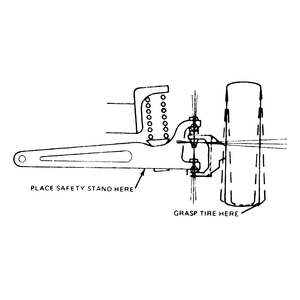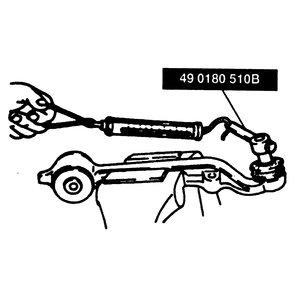| Fig. 1: Checking the ball joints

|
- Check and adjust the front wheel bearings. Raise and support the vehicle.
- Have a helper grasp the lower edge of the tire and move the wheel assembly
in and out.
- While the wheel is being moved, observe the lower spindle arm and the lower
part of the axle jaw.
- A 1⁄32 in.
(0.8mm) or greater movement between the lower part of the axle jaw and the
lower spindle arm indicates that the lower ball joint must be replaced
- To check the upper ball joints, while the wheel is being moved, observe
the upper spindle arm and the upper part of the axle jaw.
- A 1⁄32 in.
(0.8mm) or greater movement between the upper part of the axle jaw and the
upper spindle arm indicates that the upper ball joint must be replaced
Defective ball joints are determined by checking the rotational torque with
a special preload attachment and spring scale.
- Remove the lower control arm from the vehicle.
- Inspect the control arm for damage and the boots for cracks. Replace them
if necessary.
- Inspect the ball joint for looseness and replace, if necessary.
- Shake the ball joint stud at least 5 times.
| Fig. 2: Inspecting the rotational torque of the ball
joint using a spring scale

|
- Install tool 49 0180 510B or equivalent to the ball joint stud and attach
a suitable pull scale to the stud.
- After shaking the ball joint stud back and forth 5 times, measure the rotational
torque while the ball joint stud is rotating. The rotational torque should
be 18–30 inch lbs. (2–3 Nm). The pull scale reading should be
4.4–7.7 lbs.
- If the reading is not as specified, replace the lower ball joint (4WD) or
control arm assembly (rear wheel drive).

